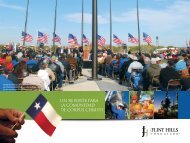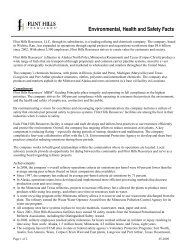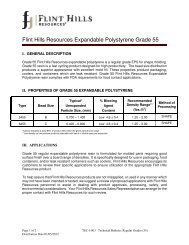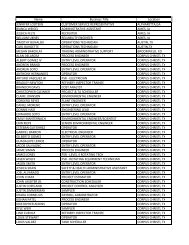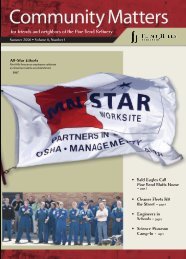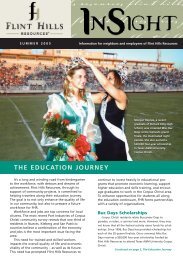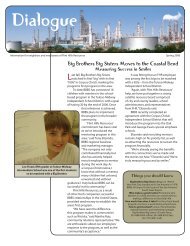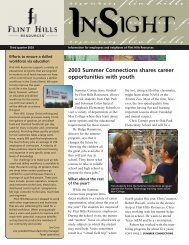for friends and neighbors of the Pine Bend Refinery - Flint Hills ...
for friends and neighbors of the Pine Bend Refinery - Flint Hills ...
for friends and neighbors of the Pine Bend Refinery - Flint Hills ...
You also want an ePaper? Increase the reach of your titles
YUMPU automatically turns print PDFs into web optimized ePapers that Google loves.
E D U C A T I O N A L<br />
I N I T I A T I V E S<br />
Dino-Night!<br />
Families Experience Good Times, Great Discoveries at Science Museum Outreach Program<br />
Salem <strong>Hills</strong> Elementary School<br />
students <strong>and</strong> <strong>the</strong>ir parents<br />
rolled-up <strong>the</strong>ir sleeves <strong>and</strong><br />
took part in <strong>the</strong> Science Museum <strong>of</strong><br />
Minnesota’s School Outreach program<br />
recently. Toge<strong>the</strong>r, <strong>the</strong>y tackled fun,<br />
h<strong>and</strong>s-on learning activities such as<br />
building a prehistoric champsosaur<br />
<strong>and</strong> discovering fossil fragments<br />
embedded in rock.<br />
It definitely was not a typical homework<br />
assignment <strong>for</strong> Salem <strong>Hills</strong> first<strong>and</strong><br />
fourth-graders. The family night<br />
component – Digging Into The Past –<br />
was <strong>the</strong> culmination <strong>of</strong> a week-long residency<br />
program presented by Science<br />
Museum educators <strong>and</strong> sponsored by<br />
<strong>Flint</strong> <strong>Hills</strong> Resources. More than 100<br />
parents <strong>and</strong> <strong>the</strong>ir children participated<br />
in <strong>the</strong> event that included a science<br />
Science Museum Outreach instructor Kim Bennett helped Salem <strong>Hills</strong> Elementary School<br />
students during <strong>the</strong> "Digging Into <strong>the</strong> Past" family night last November.<br />
demonstration as<br />
well as activities that<br />
gave kids a chance to<br />
teach <strong>the</strong>ir parents a<br />
little about what <strong>the</strong>y<br />
learned during <strong>the</strong>ir<br />
week-long studies.<br />
Rick Lucas, <strong>Pine</strong> <strong>Bend</strong><br />
employee, welcomed<br />
families <strong>and</strong> talked<br />
through <strong>the</strong> refinery’s<br />
ongoing commitment<br />
to fur<strong>the</strong>ring science<br />
education in schools.<br />
“The <strong>Flint</strong> <strong>Hills</strong> family<br />
science night has<br />
become an annual family event at<br />
Salem <strong>Hills</strong> Elementary,” said Deborah<br />
Destad, Salem <strong>Hills</strong> Elementary principal.“The<br />
Minnesota Science Museum<br />
provides families <strong>the</strong><br />
opportunity to explore<br />
various topics each<br />
year. Students <strong>and</strong> parents<br />
experience different<br />
h<strong>and</strong>s-on science<br />
experiments that support<br />
<strong>and</strong> enrich our<br />
science curriculum.”<br />
The traveling science<br />
curriculum<br />
makes its way to more<br />
than 17 Dakota <strong>and</strong><br />
Washington County<br />
elementary schools<br />
over <strong>the</strong> course <strong>of</strong> <strong>the</strong><br />
school year – from<br />
Hastings to Cottage Grove to Inver<br />
Grove Heights. Science Museum<br />
instructors team with first- through<br />
fifth-grade teachers in <strong>the</strong> classroom to<br />
help students learn about science in a<br />
fun <strong>and</strong> interesting way.<br />
Props like fossils, real dinosaur bones<br />
<strong>and</strong> paleontologist tools help spark kids’<br />
interest in science as part <strong>of</strong> <strong>the</strong> school<br />
outreach tour. There are nine different<br />
science-<strong>the</strong>med curriculums which<br />
schools can choose from, including<br />
wea<strong>the</strong>r, electricity <strong>and</strong> geography.<br />
<strong>Flint</strong> <strong>Hills</strong> has helped fund <strong>the</strong> program<br />
in Dakota County schools since<br />
1998. The curriculum also includes an<br />
instructor workshop at <strong>the</strong> Science<br />
Museum where teachers learn how to<br />
integrate <strong>the</strong> museum’s curriculum into<br />
<strong>the</strong>ir own lesson plans.<br />
Dig It!<br />
5<br />
A Salem <strong>Hills</strong> Elementary alumna was on h<strong>and</strong> to<br />
share her own dino-digging experience. Susie Meyer<br />
spent a week last summer searching <strong>for</strong> fossils at a dig<br />
site in Marmath, N.D. as part <strong>of</strong> an outing with youth volunteer<br />
members <strong>of</strong> <strong>the</strong> Minnesota Children’s Museum<br />
Exhibit Squad.<br />
Meyer brought along a few <strong>of</strong> her favorite fossils <strong>and</strong><br />
a great story <strong>of</strong> how she helped unearth a 75-millionyear-old<br />
fossilized triceratops horn. The horn will be displayed<br />
at <strong>the</strong> Children’s Museum beginning February 22<br />
as part <strong>of</strong> <strong>the</strong> Dinosaurs: A Prehistoric Playground exhibit.<br />
The young paleontologist also shared a secret tip on<br />
detecting bone during a fossil dig.“While you’re<br />
prospecting <strong>for</strong> clues, you’ll usually come across little<br />
chunks <strong>of</strong> materials sticking out <strong>of</strong> <strong>the</strong> rock. If you lick<br />
<strong>the</strong> rock <strong>and</strong> <strong>the</strong> fragments stick to your tongue – you’ve<br />
found bone remains. If <strong>the</strong>y don’t stick, <strong>the</strong> fragments<br />
are just rock.”<br />
The fossil dig was led by Doug Hanks, a paleontologist<br />
from <strong>the</strong> Science Museum <strong>of</strong> Minnesota, who brings<br />
groups <strong>of</strong> students to prospect <strong>for</strong> prehistoric bones <strong>and</strong><br />
fossils in North Dakota, Iowa <strong>and</strong> Minnesota. In addition<br />
to <strong>the</strong> 25-foot-long triceratops horn, <strong>the</strong> dino-mite diggers<br />
also helped uncover a 12-foot-long leg bone <strong>of</strong> a<br />
duck-billed dinosaur.<br />
Suzie Meyer (top, second from right) <strong>and</strong> her talented paleontologist teammates showed <strong>of</strong>f <strong>the</strong>ir big<br />
find - part <strong>of</strong> a juvenile triceratops horn estimated to be 75 million years old.The girls spent a week<br />
unearthing prehistoric fossils at a dig site in Marmath, N.D.They used real dig tools - such as pick axes,<br />
shovels <strong>and</strong> files - to unearth a variety <strong>of</strong> bones, fossils, teeth <strong>and</strong> o<strong>the</strong>r clues into <strong>the</strong> past.



